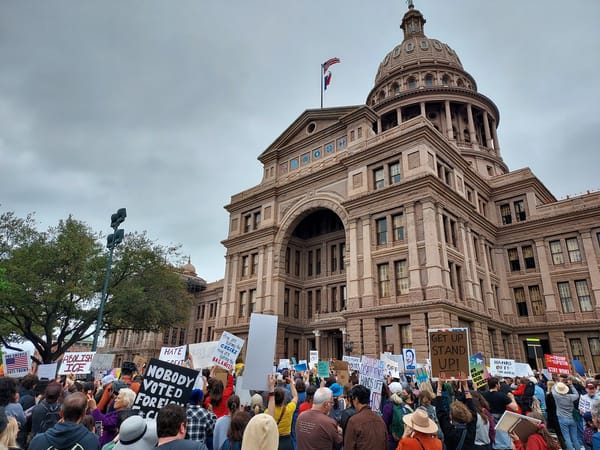Feminism with YIMBY Characteristics

Much hay has been made about the effects of our housing crisis on economic inequality, racial segregation, and climate catastrophe. Today I want to approach the question of housing from a feminist perspective. Does our policy of scarce, expensive housing have implications for the feminist project? Conversely, does the pro-housing YIMBY (Yes In My Back Yard) movement have anything to offer the feminist project? I answer: yes, and yes.
But first, let me define my terms. By “feminism” I mean nothing less than the project of liberating us all from the shackles of this thing called patriarchy. What is patriarchy? A material structure of power that elevates patriarchs and then divides the rest of the social world up according to how useful we are to those patriarchs: mothers, children, servants. (As I elaborate at more length here). Following Kate Manne, this material structure of power is attended by an ideology that justifies it, sexism, and an enforcement mechanism that punishes those who step out of line, misogyny. Liberating us from those inner shackles of sexism and misogyny via consciousness-raising is an essential part of the feminist project—but feminism does not consist in the mere refutation of an idea or two. Feminism is the project of material liberation from a material system of power. Feminism works for a world in which no one is forced by their dependence on the material structures of patriarchy into the social structures of patriarchy—or put less fancifully, in which everyone is free to pursue their own plan of life without enforced conformity with the patriarchal one.
What is “YIMBYism”? It is a truth universally acknowledged that the rent is too damn high. What YIMBYism offers is a diagnosis and a plan. The rent is too damn high because there are too many people trying to buy too few homes. This is because of artificial restrictions on the supply of homes: most famously, exclusionary zoning, but also numerous others. Therefore, we must remove those artificial restrictions so that we can have enough affordable homes for people to live near good jobs, good schools, and good amenities.
These fundamentals in place, the thesis of this essay is simple: the scarcity of housing itself functions to maintain the material power of patriarchy. The scarcity of housing functions to keep variously marginalized persons dependent on or abused by superordinate persons. The scarcity of housing functions as a chain tying vulnerable people to the nuclear family. Scarce, expensive housing is incompatible with a free society.
Let’s start with an illustrative example. About 7% of the overall youth population is queer. About 40% of the homeless youth population is queer. Of those homeless queer kids, the overwhelming majority are homeless because they were kicked out by their families. Numerous others left because of abuse or because of other family issues. This paints one picture of the patriarchy at its horrific work—the nuclear family’s stranglehold on housing leveraged to punish patriarchy’s outcasts.
But there is another picture here, one visible in the negative space of the above statistics: the people who don’t leave, or who can’t. The ones for whom the threat of homelessness functions as a chain, tying them to their abusers. This is queer kids, but it’s not just queer kids. It’s everyone stuck with a partner they can’t leave because they need to make the mortgage, or because they can’t afford rent alone. It’s everyone stuck in the closet because their partner would show them the door the minute they came out. It’s everyone who settles for patriarchy because we have made freedom unaffordable.
We did not get here by accident. As with many things in America, the present comes into clearer focus once its history is made visible. So let us take a trip down history lane, back to the formation of modern America under the shaping powers of the New Deal. In her Family Values, Melinda Cooper argues that the New Deal restructured American society around the “Fordist family wage.” The Fordist family wage is a simple idea: that a white man working a good (union) factory job could earn enough to support a family (wife and children) and himself over the whole course of their lives (college and retirement). That factory job would provide health care, workmen’s comp, retirement savings, and a college education for his kids.
A good life, if you could get it. Because at the same time, the New Deal structured society in order to exclude large swathes of people from that system: women and Black Americans especially. Because if you orient society around making sure that only a certain class of persons can live a whole and complete life, you inherently ensure that others cannot. So whence do they derive their sustenance? Service. From servitude to those who can. The mirror image of “every white man should be able to afford a wife and a servant” is “every white woman should have no choice but to be a wife” and “every black person should have no choice but to serve”—at least, if they want to live well (as well as they can within the system).
What Adkins, Cooper, and Konings argue in their The Asset Economy is that as the Fordist family wage was dismantled in the 70s under the pressure of the civil rights and womens’ liberation movements, it was replaced with a new system: the asset economy. Rather than deriving wealth and security from a specially privileged job, wealth and security would be derived from ownership of a specially privileged asset: the family home. A bureaucratic tangle of anti-development regulations, such as exclusionary zoning, environmental laws, building codes, and community review processes worked together to strangle the supply of new housing in desirable American cities. At the same time, macroeconomic policy pumped vast sums of money into the housing market. The net result was skyrocketing housing prices.
This sounds great if you’re already a homeowner: “My home equity went up 14% last year!” And it sounds nightmarish if you’re not: “My rent went up 14% last year!” But these are both expressions of the same underlying truth: the price of housing is going through the roof, and it’s doing so as a result of deliberate economic policy at every level of society, from the Federal Reserve in Washington to your local neighborhood development council meeting.
Unlike the Fordist family wage, the asset economy does not involve de jure racial and sexual exclusion. However, the direct racism of individual agents, such as loan officers, realtors, and property assessors, large-scale patterns of investment and disinvestment—what Louise Seamster and Danielle Purifoy call “creative extraction,” plus the dead hand of past de jure segregation—the uncorrected historical concentration of wealth in the hands of the white and male, replicating itself into the future—all these things together work to maintain a chasm between the races vis-à-vis property. And getting paid 83 cents on the dollar as compared to men is no small incentive for women to look to a partner to afford housing.
The asset economy is the successor to the Fordist family wage. And like the Fordist family wage, it is an economic system explicitly designed to elevate specific persons. It recreates those same patriarchal structures: people forced into the nuclear family in order to afford housing; the subaltern classes working as gig-economy servants. The artificial scarcity of housing in America is at once a windfall to the rentier class and a yoke around the neck of everyone else. The capital order of society functions to reconstitute the patriarchal order of the family: fathers, mothers, children, servants. This is a feudal vision of society, one in which status and security derive from landowning, not labor, in which the (white) nuclear family is at the center and the rest of us forced into its orbit. And the simultaneous necessity and scarcity of housing is the linchpin of this vision. This is not a society that is compatible with feminism.
What YIMBYism has to offer feminism is therefore a vision of a new kind of city: a city where, as Rebecca Tiffany so eloquently put it, “Every trans eighteen-year-old who is stuck living with unsupportive family [is] able to afford an apartment in a vibrant urban space with transit on a minimum wage job.” This is a vision of a different way of ordering society, one based on abundant housing and well-remunerated labor. The struggle against misogyny, against transphobia, and against homophobia, are immense world-historical struggles waged in the battleground of the soul, and in their own way quite intractable. The material patterns of dependence that underpin patriarchy, on the other hand, are much more available to the levers of public policy. A program of abundant housing is a program of material emancipation of the vulnerable from patriarchy.
Housing has a special place in the economy of primary goods. Everyone needs a roof over their head. This is especially so in our modern world, in which having a stable home is a precondition of so much else—in which having an address is almost as fundamental as a social security number to participating in society. But even beyond these bureaucratic necessities, a home is a place of safety, security, privacy. Feminism with YIMBY characteristics means simply this: we should ensure that everyone can afford a place of safety, security, and privacy without needing to comply with that system of material oppression called patriarchy.
Featured Image is Keltys Worker Housing in Lufkin, Texas, by Renelibrary





